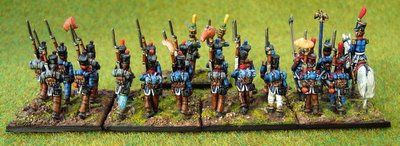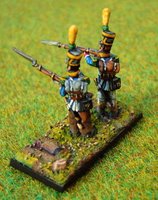More photos at the bottom of this article.
Click on image for unflattering close-up!
I have just finished painting my first French Infantry battalion using the 18mm Post-1812 Napoleonic French Infantry recently released by Eureka (& superbly sculpted by Alan Marsh) - see release. Firstly, may I take my hat off to Eureka in the efforts to produce figures for us 1815 Napoleonic enthusiasts. AB Miniatures excellent range of Napoleonic figures has sadly a gaping hole with regards to the Waterloo campaign, so I am extremely pleased to read that not only are Eureka employing Alan Marsh to fill this gap, but as of 1st March 2006, Eureka will become the sole World-Wide manufacturer of AB figures’ entire Napoleonic range and they mention in their press release, "AB Figures march to Eureka" that they have some surprises up their sleeve!
Having bought a French battalion from Fighting 15s – the site of legendry painter Ian Marsh (not to be confused with David) as a Christmas present to myself, I was instantly impressed with the detail and quality of each figure as well as the distinct lack of excess metal or “flash”. As a devotee of detail, I found I could paint the same amount as I’d apply to a 28mm figure. The only downside of miniatures of this size is the delicacy of the bayonet, which can easily snap off – c’est la vie!
Anyway, here’s a collection of photos of my first completed battalion ~ 1e 72e Regiment d’Infanterie de Ligne ~ or in English, 1st Batallion 72nd Line Infantry Regiment based according to General de Brigade rules (1 figure = 20 men).
1e Batallion 72e Regiment d’Infanterie de Ligne (1815)
Acting GOC Chef d’Bataillon Thibault
Attached to: 5e French Infantry Division – 2e Brigade under Général de Brigade Campi
Basing:
A full-strength French line infantry battalion of 720 men would consist of 6 bases:
Base 1: Command (x1 GOC Regt. x1 Eagle x1 Escort) + 1st Company of Fusiliers (x3 figures)
Base 2: 2nd Company of Fusiliers (x6 figures)
Base 3: 3rd Company of Fusiliers (x6 figures)
Base 4: 4th Company of Fusiliers (x6 figures)
Base 5: Company of Grenadiers (x6 figures)
Base 6 & Base 7: Company of Voltigeurs (x3 figures per base for skirmishing)
Like most French line infantry battalions in the Waterloo Campaign, the 1e 72e was under strength numbering 483 men all ranks. This equates to a 24 figure battalion and, as you can see in the photos, I have adapted the above formula to accommodate the battalion being under strength, i.e.
Base 1: Command (x1 GOC Regt. x1 Eagle x1 Escort) + less than half a Company of Grenadiers (x2 figures)
Base 2: 2nd Company of Fusiliers (x6 figures)
Base 3: 3rd Company of Fusiliers (x6 figures)
Base 4: 4th Company of Fusiliers (x5 figures)
Base 5: Not applicable (Grenadiers accommodated within Command base)
Base 6: less than half a Company of Voltigeurs (x2 figures per base for skirmishing)
= 24 figures i.e. 480 men.
Each Company base is 3cm x 3cm and easily accommodates a max. of x6 18mm figures. The anomalies in the 1e 72e are:
Anomolies:
- Normally the GOC (General Officer Commanding) an infantry regiment was a Colonel but in the case of 1e 72e there was an acting GOC who was a rank below, i.e. Chef d’Bataillon Thibault. Therefore, for the purists, you will note I have painted his plume all white with one gold band around his shako signifying the rank of CdB and not a red plume with two gold bands for a Colonel – call me fussy if you want.
- I have incorporated the Grenadiers into the Command base.
- I only have one base of Voltigeurs and if you look closely you’ll see a furrow made by a cannon ball where the third Voltigeur should be! TIP: Use any space where a figure would normally be creatively!
- The 4th Company of Fusiliers has a figure missing and again, if you look at the relevant photo, you’ll notice a small crater with canon ball imbedded in it!
Finally, to add a bit of realism, I’ve placed a couple of loafs of bread and two slabs of pork on the bayonets of 4 figures. Again, for purists comme moi, infantryman often carried food skewered on their bayonets due to lack of room in their haversack – if they were fortunate to have one. - French infantry in 1815 were very poorly equipped with many conscripts issued only with a shako, greatcoat, belts and musket, wearing civilian clothes underneath! To depict this dire state of affairs, I have painted the trousers a variety of colours other than the regulation campaign blue or white.
- Finally, despite the 16th June being a fine hot summers day, the 17th was one of the wettest and when units met on 18 June at Waterloo, their uniforms would have been extremely muddy. Therefore, I have painted mud on the trousers and the bases show churned up grass.
Well, 24 figures down and 2, 476 to go! Merde!
JC
1 February 2006
---------------------------------------------
NOTE: When viewing my figures close-up please remember that they were NOT painted for such close inspection and are best viewed atop a wargaming table. Let's just say that I'm allowing you to see how my paint is applied. And for the purists who lean toward more realistic blending, I promise to have a go at this style when I begin painting the 2e battalion.
Command Base
2e Fusilier Company / 3rd Fusilier Company
4th Fusilier Company
Voltigeurs
Column Attack!
Painted ~ Unpainted!














4 comments:
Did you say UN-flattering close ups? I'm blown away! Fantastic job!
Why did you not simply have 4 figures per company when organising your first French battalion?
Good lord! Those are incredibly impressive! Why ever do you feel you need to apologize for them? :-)
I'd be embarassed to have my figures on the same game table as you... my figures look like I dunked them into paint compared to yours.
At least I've only been painting for a month... I can look for a skill level to aspire to.
Post a Comment